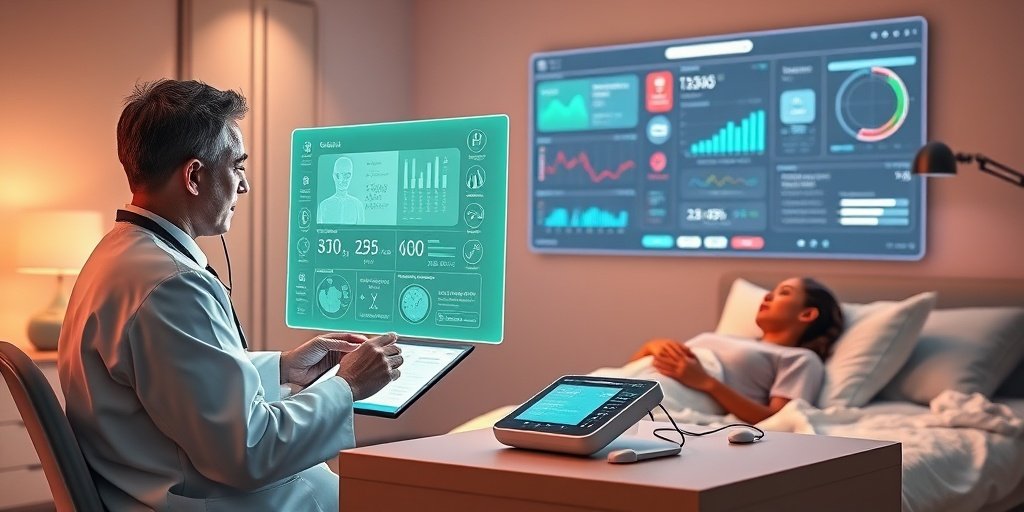⚡ Quick Summary
This article discusses the transformative role of telehealth and integrated care in addressing the challenges faced in men’s health urology, particularly in improving access to care and patient outcomes. With a significant shortage of urologists and high mortality rates from conditions like prostate cancer, these innovations offer a promising pathway to enhance care quality and reduce health disparities.
🔍 Key Details
- 📊 Key Issue: 62% of US counties lack a practicing urologist.
- ⚠️ Health Disparity: African American men face twice the mortality rate from prostate cancer compared to other groups.
- 💻 Technology: Telehealth and AI-driven tools are central to integrated care models.
- 📈 Benefits: Improved access, reduced costs, and enhanced patient outcomes.
🔑 Key Takeaways
- 🌐 Telehealth expands access to urological care by overcoming geographical barriers.
- 🤖 AI tools enhance care delivery efficiency and accuracy.
- 🏥 Remote monitoring provides cost-effective alternatives for patient care.
- 📉 Reduced provider burnout is a significant benefit of these technologies.
- 💡 Continuous patient engagement is facilitated through digital health solutions.
- ⚖️ Health equity can be promoted by leveraging these innovations.
- 💰 Cost savings are achievable through integrated care models.
- 📅 Future Research: Further exploration of telehealth’s impact on men’s health is needed.

📚 Background
Men’s health, particularly in urology, is often hindered by access issues, health disparities, and a shortage of specialists. Prostate cancer remains a leading cause of cancer-related deaths among men, with certain demographics, such as African American men, disproportionately affected. The current healthcare landscape necessitates innovative solutions to bridge these gaps and improve patient outcomes.
🗒️ Study
The article explores the applications of telehealth and integrated care models in men’s health urology, highlighting their potential to address the critical shortage of urologists and the associated delays in diagnosis and treatment. By utilizing technology, healthcare providers can offer virtual consultations, at-home diagnostics, and ongoing patient engagement, which are essential in today’s healthcare environment.
📈 Results
The integration of telehealth and AI-driven tools has shown to significantly improve provider experience by automating administrative tasks and facilitating early interventions through predictive analytics. These advancements not only enhance the efficiency of care delivery but also lead to better patient outcomes, reduced healthcare costs, and lower rates of provider burnout.
🌍 Impact and Implications
The findings from this study underscore the potential of telehealth and integrated care models to revolutionize men’s health urology. By leveraging digital health solutions, healthcare systems can promote health equity, increase patient engagement, and ensure timely access to effective urological care. This shift could significantly improve health outcomes and reduce disparities in care.
🔮 Conclusion
The exploration of telehealth and integrated care in men’s health urology reveals a promising avenue for addressing longstanding challenges in access and outcomes. By embracing these technologies, healthcare providers can enhance the quality of care delivered to men, ultimately leading to improved health outcomes and a more equitable healthcare system. Continued research and implementation of these solutions are essential for the future of men’s health.
💬 Your comments
What are your thoughts on the role of telehealth in improving men’s health urology? We invite you to share your insights and engage in the conversation! 💬 Leave your comments below or connect with us on social media:
Applications and Outcomes of Telehealth and Integrated Care in Men’s Health Urology.
Abstract
Men’s health, particularly in the domain of urology, faces significant challenges in access to care, patient outcomes, and cost efficiency. Despite advances in medical treatment, conditions such as prostate cancer remain a leading cause of cancer-related death among men, with African American men disproportionately affected at twice the mortality rate of other groups. Compounding these challenges is a critical shortage of urologists, with 62% of US counties lacking a practicing urologist and only 1 new urologist entering the field for every 10 retiring. This shortage results in delayed diagnoses, increased rates of advanced-stage conditions, and significant health disparities. To address these pressing issues, telehealth and technology-based integrated care models present a promising solution. Telehealth expands access to specialized urological care by overcoming geographical barriers and offering virtual consultations, at-home diagnostics, and continuous patient engagement. Artificial intelligence-driven tools further enhance the efficiency and accuracy of care delivery, improving provider experience by automating administrative tasks and facilitating early intervention through predictive analytics. Furthermore, remote patient monitoring devices provide accurate, cost-effective, and highly accessible alternatives. These innovations reduce provider burnout, lower health care costs, and, critically, improve patient outcomes. This paper explores the potential of telehealth and integrated care in men’s health urology as a practical pathway to bridging access gaps, enhancing care quality, and achieving cost savings. By leveraging digital health solutions, health care systems and employers can promote health equity, increase engagement, and ensure that all men receive timely and effective urological care.
Author: [‘Bisset B’, ‘Shriram T’, ‘Davuluri M’, ‘Azar H’, ‘Beilan J’, ‘Amin R’, ‘Houman J’]
Journal: J Med Internet Res
Citation: Bisset B, et al. Applications and Outcomes of Telehealth and Integrated Care in Men’s Health Urology. Applications and Outcomes of Telehealth and Integrated Care in Men’s Health Urology. 2025; 27:e69095. doi: 10.2196/69095